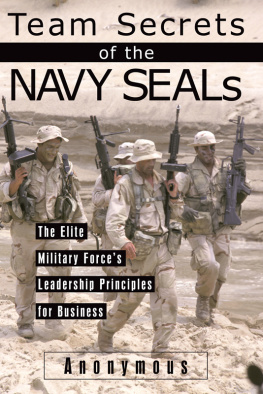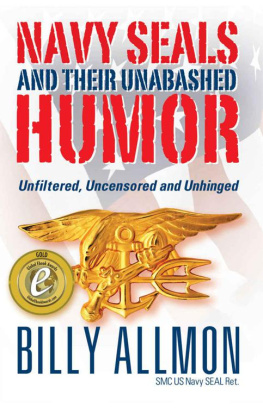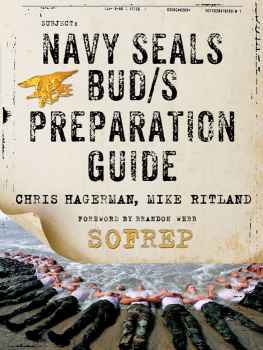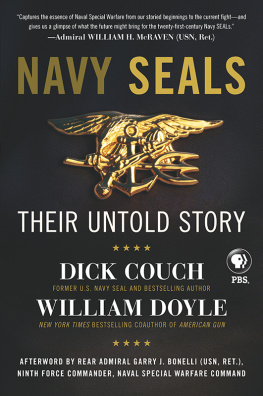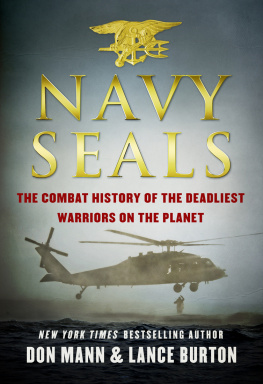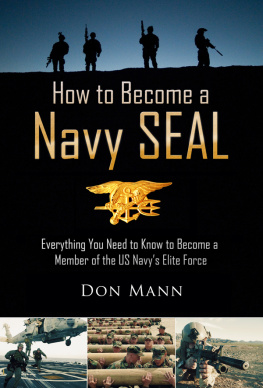

Team Secrets of the Navy SEALs: The Elite Military Forces Leadership Principles for Business copyright 2003 by Lionheart Books, Ltd. All rights reserved. No part of this book may be used or reproduced in any manner whatsoever without written permission except in the case of reprints in the context of reviews. For information, write Andrews McMeel Publishing, an Andrews McMeel Universal company, 1130 Walnut Street, Kansas City, Missouri 64106.
www.andrewsmcmeel.com
APPR
Library of Congress Cataloging-in-Publication Data
Team secrets of the Navy SEALs : the elite military forces leadership principles for business / Anonymous.
p. cm.
E-ISBN: 978-0-7407-8651-8
1. Teams in the workplace. 2. Leadership. 3. United States. Navy. SEALs. I. Title: Elite military forces leadership principles for business. II. Title.
HD66.N44 2003
658.402dc21
2002044061
Book design and composition by Just Your Type.
Jacket design by Van Crosby
Cover photo by Hans Halberstadt
ATTENTION: SCHOOLS AND BUSINESSES
Andrews McMeel books are available at quantity discounts with bulk purchase for educational, business, or sales promotional use. For information, please write to: Special Sales Department, Andrews McMeel Publishing, 1130 Walnut Street, Kansas City, Missouri 64106.
C ONTENTS
Introduction
Background of the Teams
Chapter 1
Leading the Best
Chapter 2
Know Who Youve Got
Chapter 3
Setting the Stage
Chapter 4
The Pragmatic Pedestal
Chapter 5
Have an Open-Door Policy for Opportunity
Chapter 6
Handling Burnout
Chapter 7
Flexibly Inflexible
Chapter 8
The Menace of Micromanagement
Chapter 9
Preventive Maintenance
Chapter 10
The Four Links
Chapter 11
Teammates, Not Lackeys
Chapter 12
What Is Expected from You
Conclusion
Lessons Learned
A BOUT THE A UTHOR
The author of Team Secrets of the Navy SEALs is a seasoned professional in the U.S. militarys elite fighting force. All names will be kept secret to protect him, his fellow members of the Naval Special Warfare community, their families, their superiors, and their missions.
I NTRODUCTION
Background of the Teams
S ince the establishment of our force, Frogmen have willingly put themselves at risk so that others may live free and fruitful lives. The men of Naval Special Warfare are willing to go where and do what others cannot or will not.
Naval Special Warfare has always been and always will be a strictly volunteer organization. If at any time a Frogman wishes to leave, he may do so. When a Team member is unwilling to complete an assigned task, there is no sense in bringing him along; others are already waiting for the opportunity to prove their mettle. This important parallel to the business world is the basis of the lessons in this book.
In World War II, U.S. forces took heavy losses because of their inexperience with amphibious operations and at acquiring intelligence. Procuring information about the composition of beachheads, the firmness of the sand, and the location of sandbars, coral reefs, and man-made obstacles became absolutely imperative. The technology behind todays satellites, which provide immediate and up-to-date imagery, was still decades away. The question was how to get such detailed and current information. The answer was Naval Combat Demolition Units (NCDUs), amphibious reconnaissance forces that operated in advance of conventional troops, at great personal risk.
These Frogmen were men so dedicated to their country that they were willing to do whatever was asked of them. They often went into combat wearing only swim trunks, a knife, a mask, fins, and a satchel of explosives. This earned them several names, the two most noted and cherished being naked warriors and Frogmen. In a time before wet suits, these men of iron resolve would cover their bodies with axle grease to fight off the bone-chilling waters of the Atlantic.
Over time, the forces became known as UDTs (Underwater Demolition Teams). During the Korean War the UDTs began a transition to hinterland operations, conducting small demolition raids. After the Korean War the need for antiguerrilla warriors was recognized. In 1961 President Kennedy commissioned the first two SEAL Teams (Sea, Air, Land Teams) to conduct unconventional warfare. (SEAL Team One was based on the West Coast, SEAL Team Two on the East Coast.) UDTs were still in existence; however, they were slowly phased out over the next few decades as more SEAL Teams were commissioned.
SEALs saw their first combat during the Vietnam War, earning them a reputation as the most ruthless operators, accepting and completing missions that others would not even consider. Although SEALs were killed, not one was ever left behind or captured. This is a fact that all SEALs value and live by, and it is the basis of the Team concept.
From the very first days of the Frogman lineage up to the time this book was published, only 240 classes and a handful more than 6,500 men have made the grade.
To date, not one man involved in a SEAL operation has ever been left behind.
C HAPTER 1
Leading the Best
Navy SEALs Concepts for Leading Professionals and Team Building
Every moment of a SEALs life is geared toward the Team! The word Team encompasses everything from the platoon to our entire country. In the Teams, men work relentlessly with their Teammates and face incredible odds to accomplish their missions.
What would you think if your boss told you that you were going to push a boat out of an airplane at night and then jump out after it, deploying your own parachute and chasing the boat to the water with seven other people and without the help of any lights? Next, youll need to maneuver out of your parachute and get the boat operational in ten minutes, because you have to pick up eight more men who are about to jump into the water. Then youll have to paddle for several hours and rendezvous at a predesignated meeting pointall under the cloak of one nights darkness. A sixteen-man Teamtwo officers and fourteen enlisted mencomplete all the planning, preparation, coordination, supervision, and execution of such a mission.
That mission is just the one youll be doing this week. Every day of this week and the next, and the next after that, you will be responsible for the lives of your Team members, either in training or in combat. The only way you can survive is to trust your Team and be trusted by them. You cant think only of yourself. Everyones life depends on each member thinking as a Team. This is my life, and this is how I survive. The principles of SEAL Team leadership and cohesiveness apply to all Teams; and strong Teams, in business and in life, are ruthlessly effective in achieving their common goals.
I am an active-duty Navy SEAL and will not use my real name or that of any of my brothers. Many of my closest friends are also still on active duty, and it would be inappropriate to proffer their identities as well. I have built this book, however, with stories from my own experience. Lead by example, build a stronger Team, and over time you will create a successful business and career.

